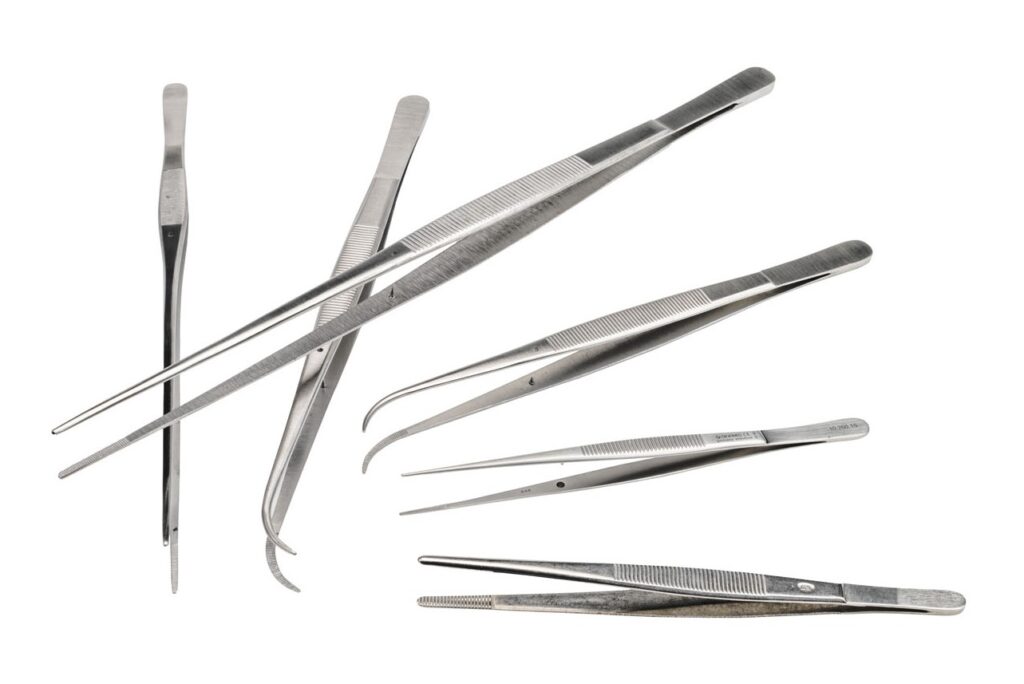In the realm of surgical instruments, forceps and hemostats are vital tools with specific functions that contribute significantly to successful medical procedures. While they may share some similarities in appearance, their primary purposes, designs, and applications differ quite a lot. This blog post aims to unravel the key differences between forceps and hemostats, shedding light on their unique roles in the field of medicine.
Forceps
Function and Purpose: Forceps are surgical instruments with pincers-like tips designed to grasp, hold, and manipulate tissues, sutures, or other objects during various medical procedures. They are used to maintain a firm grip on delicate tissues, allowing surgeons to accurately position, manipulate, or extract them as needed.
Design: Forceps come in a variety of designs tailored to specific tasks. Some forceps have fine, delicate tips for handling delicate tissues, while others have broader, serrated tips for gripping materials like dressings or tissue. The handles of forceps are designed to provide surgeons with a comfortable grip, enabling precise control during procedures.
Applications: Forceps find application in a wide range of surgical procedures, including wound exploration, tissue manipulation, suturing, and organ handling. Their versatility makes them indispensable tools in various medical specialties, from general surgery to obstetrics and gynecology.
Hemostats
Function and Purpose: Hemostats, also known as hemostatic forceps, serve a distinct purpose: controlling bleeding during surgical procedures. These instruments are designed to clamp blood vessels, restricting blood flow and minimizing hemorrhage. Hemostats are particularly crucial when working in areas with high vascularity, such as during surgeries involving blood vessels or organs.
Design: Hemostats are characterized by their locking mechanism, which allows them to maintain constant pressure on vessels or tissues without continuous manual gripping. This self-retaining feature makes hemostats ideal for situations where a continuous and controlled level of pressure is necessary to achieve hemostasis.
Applications: Hemostats are primarily used to control bleeding by clamping blood vessels temporarily. They are vital tools in surgeries where precise control of blood flow is essential, such as vascular procedures, organ transplants, and procedures involving delicate tissues that are prone to bleeding.
Key Differences
- Primary Function: The most significant difference between forceps and hemostats lies in their primary functions. Forceps are designed for gripping and manipulation, while hemostats are specifically engineered for blood vessel clamping to control bleeding.
- Locking Mechanism: Hemostats possess a locking mechanism that enables them to maintain a constant pressure on tissues or vessels without requiring continuous manual force. Forceps lack this feature and need to be held manually throughout the procedure.
- Design and Tips: Forceps come in various tip designs suited for different tasks, such as fine-pointed tips for delicate tissues or broader tips for grasping materials. Hemostats have serrated jaws designed for gripping vessels securely.
- Applications: Forceps are versatile tools used for tissue manipulation, suturing, and other general surgical tasks. Hemostats are specialized instruments primarily used in procedures involving blood vessels and to control bleeding.
- Medical Specialties: Forceps find applications across multiple medical specialties, from general surgery to obstetrics. Hemostats are commonly used in specialties like vascular surgery, cardiothoracic surgery, and other procedures involving blood vessels.
Distinctly Different Tools
While forceps and hemostats may share some visual resemblance, their roles, designs, and applications are markedly distinct. Forceps excel in grasping, holding, and manipulating tissues during various surgical procedures. On the other hand, hemostats shine as essential tools in controlling bleeding by clamping blood vessels, offering a self-retaining mechanism that provides consistent pressure.
Understanding the key differences between these two instruments is essential for healthcare professionals to ensure their proper use in different surgical contexts. Their individual roles contribute to the overall success of medical procedures, highlighting the intricacies and specialized nature of surgical instruments in delivering safe and effective patient care.
About Rigor Instruments
High-quality surgical instruments are essential to the success of any procedure, no matter how straightforward or difficult it may be for the patient, and this is where Rigor Instruments can help you.
Rigor is a second-generation surgical instruments manufacturer and surgical instruments supplier from Sialkot Pakistan providing best quality in all kinds of Surgical Instruments since 1985. Our surgical instruments include electro surgical instruments, neuro surgical instruments, plastic surgery instruments, dental surgical instruments, retractors, forceps surgical instruments, general surgical instruments, ophthalmic surgical instruments, ENT surgical instruments and many more.
We are the best surgical instruments company Pakistan, offering exquisite quality and competitive pricing. It has given us a great competitive advantage in the global surgical instruments market representing surgical instruments Sialkot Pakistan. Our ambition is to become a leader in international market in all Surgical Instruments.











